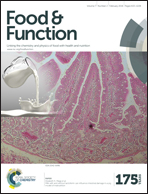Fermented goat milk consumption improves melatonin levels and influences positively the antioxidant status during nutritional ferropenic anemia recovery
Abstract
The aim of the current study was to assess the influence of fermented goat or cow milk on melatonin levels and antioxidant status and during anemia recovery. Eighty male Wistar rats were placed on a pre-experimental period of 40 days and randomly divided into two groups, a control group receiving normal-Fe diet (45 mg kg−1) and the Fe-deficient group receiving low-Fe diet (5 mg kg−1). Then, the rats were fed with fermented goat or cow milk-based diets with a normal-Fe content or Fe-overload (450 mg kg−1) for 30 days. After 30 days of feeding the fermented milks, the total antioxidant status (TAS) was higher in both groups of animals fed fermented goat milk with the normal-Fe content. Plasma and urine 8-OHdG were lower in control and anemic rats fed fermented goat milk. Melatonin and corticosterone increased in the anemic groups during Fe replenishment with both fermented milks. Urine isoprostanes were lower in both groups fed fermented goat milk. Lipid and protein oxidative damage were higher in all tissues with fermented cow milk. During anemia instauration, an increase in melatonin was observed, a fact that would improve the energy metabolism and impaired inflammatory signaling, however, during anemia recovery, fermented goat milk had positive effects on melatonin and TAS, even in the case of Fe-overload, limiting the evoked oxidative damage.


 Please wait while we load your content...
Please wait while we load your content...